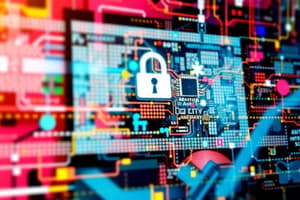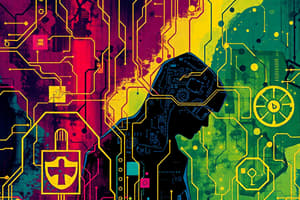Podcast
Questions and Answers
What are computer information systems vulnerable to?
What are computer information systems vulnerable to?
Computer information systems are vulnerable to physical attacks, electronic hacking, and natural disasters.
What is a computer threat in general?
What is a computer threat in general?
A computer threat, in general, can be a person or a thing that is likely to cause damage or danger to private or any data of a user or organization or any system.
What is a crime in the context of computer security?
What is a crime in the context of computer security?
A crime is considered an action or omission that constitutes an offense that can be prosecuted by the state and is punishable by law.
What defines a perpetrator in computer crimes?
What defines a perpetrator in computer crimes?
Which of these is NOT a type of perpetrator in computer crime?
Which of these is NOT a type of perpetrator in computer crime?
What is the objective of a hacker?
What is the objective of a hacker?
What is the objective of an insider?
What is the objective of an insider?
What is the objective of an industrial spy?
What is the objective of an industrial spy?
What is the objective of a cybercriminal?
What is the objective of a cybercriminal?
What is the objective of a cyberterrorist?
What is the objective of a cyberterrorist?
Hackers are always malicious.
Hackers are always malicious.
Crackers are typically considered ethical hackers.
Crackers are typically considered ethical hackers.
Insiders pose a significant risk because they have access to sensitive information.
Insiders pose a significant risk because they have access to sensitive information.
What are white hat hackers?
What are white hat hackers?
What is a virus in computer security?
What is a virus in computer security?
Flashcards
Computer Threat
Computer Threat
Anything that can potentially harm or damage a computer system, data, or user.
Computer Crime
Computer Crime
An offense that is illegal, can be prosecuted by the state, and carries a punishment.
Cracker
Cracker
Someone who accesses computers and networks with malicious intent, often to steal data or cause disruption.
Malicious Insider
Malicious Insider
Signup and view all the flashcards
Industrial Spy
Industrial Spy
Signup and view all the flashcards
Cybercriminals
Cybercriminals
Signup and view all the flashcards
Cyberterrorist
Cyberterrorist
Signup and view all the flashcards
Virus
Virus
Signup and view all the flashcards
Worm
Worm
Signup and view all the flashcards
Trojan Horse
Trojan Horse
Signup and view all the flashcards
Distributed Denial of Service (DDoS)
Distributed Denial of Service (DDoS)
Signup and view all the flashcards
Logic Bomb
Logic Bomb
Signup and view all the flashcards
Phishing
Phishing
Signup and view all the flashcards
Ransomware
Ransomware
Signup and view all the flashcards
Spam
Spam
Signup and view all the flashcards
Adware
Adware
Signup and view all the flashcards
Spyware
Spyware
Signup and view all the flashcards
White Hat Hacker
White Hat Hacker
Signup and view all the flashcards
Black Hat Hacker
Black Hat Hacker
Signup and view all the flashcards
Hacker
Hacker
Signup and view all the flashcards
Worm
Worm
Signup and view all the flashcards
Trojan Horse
Trojan Horse
Signup and view all the flashcards
Targeted Malware
Targeted Malware
Signup and view all the flashcards
Phishing
Phishing
Signup and view all the flashcards
Ransomware
Ransomware
Signup and view all the flashcards
Distributed Denial of Service (DDoS)
Distributed Denial of Service (DDoS)
Signup and view all the flashcards
SQL Injection
SQL Injection
Signup and view all the flashcards
Spyware
Spyware
Signup and view all the flashcards
Hacking
Hacking
Signup and view all the flashcards
Virus
Virus
Signup and view all the flashcards
Study Notes
Computer Threats
- Computer information systems are vulnerable to physical attacks, hacking, and natural disasters.
- A computer threat is a person or thing that causes damage to data, systems, or users. This can include actions like removing, stealing, or manipulating data.
Types of Computer Crime Perpetrators
- Hacker: Tests system limits, often for publicity; limited resources; minimal risk taking; high frequency of attack.
- Cracker: Causes problems, steals data, corrupts systems; limited resources; moderate risk taking; medium frequency of attack.
- Insider: Financial gain or system disruption; knowledge of systems and passwords; moderate risk taking; low frequency of attack.
- Industrial Spy: Capture trade secrets or gain a competitive advantage; well funded, well trained; minimal risk taking; low frequency of attack.
- Cybercriminal: Financial gain; well funded, well trained; moderate risk taking; low frequency of attack.
- Cyberterrorist: Destruction to key infrastructure components; not necessarily well funded nor well trained; very high risk taking; low frequency of attack.
Hacker Types
- Hacker: Tests system limitations out of intellectual curiosity.
- White Hat Hacker: Uses skills for good.
- Cracker: Breaks codes and violates system integrity with malicious intent.
- Black Hat Hacker: Uses skills for bad.
- Malicious Insider: An employee, consultant, or contractor that understands the internal systems; poses a significant security concern.
Types of Computer Viruses
- Virus A program designed to harm a computer system; it replicates itself from file to file.
- Worm A destructive program that runs independently; it spreads from one computer system to another.
- Email Worm
- Internet Worm
- Instant Messaging Worm
- File Sharing Network Worm
- Trojan Horse: A program that performs a destructive action while appearing benign.
- Distributed Denial-of-Service (DDoS): Attack that floods a server to block access by legitimate users.
- Logic Bomb: A malicious code triggered by specific events.
- Phishing: An attempt to steal sensitive information (like passwords, credit card numbers).
- Ransomware: Malware that restricts access to a computer system until a payment is made.
- Spam: Unsolicited, irrelevant messages typically used for advertising, malware distribution, or phishing.
- Adware: Advertising software that displays pop-up ads on a computer.
- Spyware: Malware that gathers data about a user's online activity, often without consent.
Studying That Suits You
Use AI to generate personalized quizzes and flashcards to suit your learning preferences.




